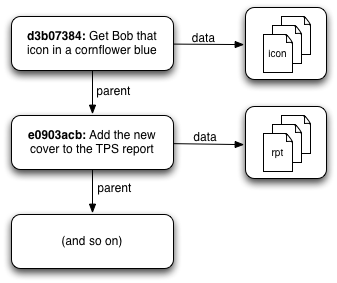Graphs and Git
The reason I've gone on at some length about graph theory is that a Git repository is one giant graph.

Git commits (simplified view)
Most of the time when you interact with Git, you're working with commits in one way or another. At the surface level, a Git commit consists of two things: (1) a pointer to the state of your code at some moment in time, and (2) zero or more pointers to "parent" commits.
(Hint: the word "pointer" means you're probably talking about a graph.)
A Git commit is a node in a graph, and each one of those nodes can point to other nodes that came before them.
- About This Site
- Git Makes More Sense When You Understand X
- Example 1: Kent Beck
- Example 2: Git for Ages 4 and Up
- Example 3: Homeomorphic Endofunctors
- Example 4: LSD and Chainsaws
- The Internet Talks Back!
- Graph Theory
- Seven Bridges of Königsberg
- Places To Go, and Ways to Get There
- Nodes and Edges
- Attaching Labels to Nodes
- Attaching Labels to Edges
- Directed Versus Undirected Graphs
- Reachability
- Graphs and Git ←HEAD
- Visualizing Your Git Repository
- References
- The Reference Reference
- Making Sense of the Display
- Garbage Collection
- Experimenting With Git
- References Make Commits Reachable
- My Humble Beginnings
- Branches as Savepoints
- Use Your Targeting Computer, Luke
- Testing Out Merges
- Rebase From the Ground Up
- Cherry-Picking Explained
- Using 'git cherry-pick' to Simulate 'git rebase'
- A Helpful Mnemonic for 'git rebase' Arguments
- The End
